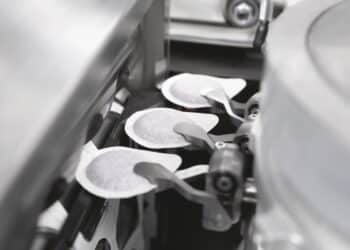Indonesia is already one of the four largest coffee producers in the world, but could the rise of specialty coffee, a booming consumer culture, and improvement in farming methods prime it for steeper growth?
Indonesia is already one of the world’s major coffee producers, but if recent comments from the country’s Coordinating Minister for Food Affairs Zulkifli Hasan are anything to go by, coffee production in the archipelago nation could be set to soar.
During the World of Coffee Asia event in Jakarta in May 2025, Hasan stated his desire to see Indonesia’s coffee production surpass that of its northern neighbour, Vietnam.
Currently the world’s second-largest producer of coffee, Vietnam is enduring a difficult farming year, with drought issues tempering future harvest expectations.
Despite this year’s expected smaller harvest, growth of the Vietnamese coffee farming sector over the past 40 years is an example of how producers – backed by government support, sustainable and industrial progress, and quality products – can disrupt the industry and emerge as a new superpower.

With Indonesia’s government likely to bolster its production sector, alongside an already established industry and untapped farming potential, the question quickly becomes not if Indonesia can increase its global production share, but how?
The perfect storm
Historically, coffee from Indonesia has typically taken the form of commercial Arabica beans grown around the Sumatra region, but that’s changing – and fast.
The consumer shift towards specialty coffee is growing in scope around the country, while farmland that previously chopped and changed between crops is starting to take a longer-term view of the potential of coffee.
Outside the traditional growing regions of Sumatra, Java, and Sulawesi, farmlands in areas like Bali and Flores are increasingly producing high-quality and specialty coffee, according to Expat. Roasters Founder Shae Macnamara.
While the opportunities in the Indonesian coffee value chain are beginning to capture more attention, Macnamara was an early admirer of the archipelago’s potential.
After founding the business in 2016, Expat now services more than 700 wholesale partners – with plans to grow that to 1000 by the end of 2025 – and operates cafés across Indonesia with new locations, including a first international site in Malaysia, launching soon.
Macnamara says the marriage between Indonesia’s coffee production potential and interest in its consumer scene have created an environment ripe for development.
“Right now, there is this amazing balance of coffee producing and coffee consuming in an economy that is super dynamic and growing fast,” says Macnamara.
“Mix that with a huge population that has a high percentage of Muslims who can’t drink alcohol and an emerging specialty coffee industry, I think it’s the perfect storm of it all coming together.”
That perfect storm was on display at this year’s World of Coffee Asia.
“I’ve travelled the world and been part of these types of events for a long time, but I’ve never seen the sort of excitement that was at a show like what was just in Jakarta,” Macnamara says.
“The Brewers Cup Final announcement felt like a rock concert. The energy in the room was electric, with the crowd yelling, jumping around, and banging on the chairs. It was incredible.
“I’ve competed, judged, coached, and spectated at these competitions for 25 years, but I have never felt anything like that. It was amazing.”

The task at hand
Indonesia produced approximately six per cent of the world’s coffee harvest in 2024/25 according to the United States Department of Agriculture, equivalent to 10.9 million 60-kilogram bags. That figure is behind only Colombia (seven per cent), Vietnam (17 per cent), and Brazil (38 per cent).
Due to its sprawling chain of islands, the country spans more than 1.9 million square kilometres, with not even a quarter of that being land. On that land, volcanoes and mountains extend up to the clouds, and thick, heavy forest covers the regional territories.
Tanamera Coffee has been active in Indonesia’s wholesale and specialty coffee markets for more than a decade, and started with a dream of growing Indonesian specialty coffee’s fame in the international landscape.
The team at Tanamera work closely with farmers to improve the quality of coffee and strength of yield coming from both Indonesia’s established and emerging regions. Co-Founder Ian Criddle says the country’s environment means the per-hectare yield will struggle to rival some of the other large producers.
“Our lowest yield of plantations is probably Flores, which is around 300 kilograms of green beans per hectare,” says Criddle. “The highest is up in Sumatra, which is circa 1200 kilograms per hectare.
“If you look at Brazil as a country, the national average is 2500 kilograms per hectare. Because all our coffee plantations are grown on the slopes of the volcanoes, it’s like a jungle – it’s up and down. Brazil is, generally, more like a flat vineyard at lower altitudes.”
Per-hectare yield is far from the only method to ascertain growth in coffee production, though.
Koro Roasters is a relatively new player in the Indonesian scene The name draws inspiration from the Italian word ‘coro’, meaning ‘choir’ or ‘collaboration’, while also creating a connection to coffee roasting – ‘kopi’ being the Indonesian word for coffee.
Founder Alain Scialoja is a former robotics engineer who has found his calling in coffee. He says Indonesia is already, in part, achieving that lofty goal set by Minister Hasan.
“Indonesia actually surpasses Vietnam in several important metrics already, it has more land dedicated to coffee production, it produces more Arabica coffee, and it has a much stronger domestic market,” says Scialoja.
“Where Vietnam leads significantly is total production volume. That difference primarily comes from Vietnam’s Robusta sector, which it has developed through a highly centralised, export-focused approach with intensive farming methods.”

Scialoja believes Indonesia won’t be able to match Vietnam’s coffee sector in terms of pure yield, but sustainable growth in production will continue to help the nation boost its coffee standings internationally.
“I believe Indonesia can certainly grow its production sustainably, perhaps by 50 per cent or more over the next decade, but rather than focusing solely on outproducing Vietnam in volume, I see more value in becoming the leader in sustainable, high-quality, traceable coffee that commands premium prices,” he says.
“Indonesia could overtake Vietnam in value terms by focusing on its competitive advantages: incredible diversity of origins, unique processing methods, and rich cultural heritage. What’s more, this approach would more greatly benefit smallholder farmers than a pure volume play.”
Sustainability at play
With coffee so susceptible to climate change, and markets around the world feeling the impacts of droughts, floods, and rising temperatures, fostering a more sustainable industry is paramount to not only coffee’s continued progress but also its survival.
This desire to improve sustainability trickles through the entire supply chain, with roasters like Expat, Koro, and Tanamera all playing their own roles in promoting sustainable practices.
Over the past decade, Tanamera has placed massive importance on its relationships with farmers across Indonesia and seeks to help them implement modern and sustainable practices.
John Lee, Director of Tanamera Coffee, oversees the business’ quality control and bean sourcing, which sees him travel between smallholder farms around the country to help improve farming practices.
“I spend a lot of time in our farming areas from Sumatra to Flores to maintain good relationships with our farmers. Even if it’s small, we always want to keep investing in our farming areas, work with farmers, and invest in machinery and education,” says Lee.
“At Tanamera we’re crop to cup, from the very beginning on the farm to the very end serving your cup of coffee. We have the customer interface, we have the experience with what people want internationally, and what people want in Indonesia for specialty grade coffee. There are apparently two million coffee farmers across Indonesia, and we can communicate all of our customer feedback with them.
“Some of them have small holdings, and some are essential processing. We help them improve their yields and the quality of the plantations to get the gains in the coffee quality.”
Criddle says the best approach to introducing new sustainable practices is to make them tangible to the farmer.
“It’s all interlinked,” he says. “John spends a lot of time with the farmers and repeats things over and over again so we can start to see tangible results. Every year, if you’re getting someone to change they have to be able to see that change.
“It’s doing things out of harvest, like pruning and weeding around trees and fertilising to get the yields up – that’s tangible to the farmer and they can
see the difference it makes.”

Koro, on the other hand, makes a point of seeking out producers already implementing sustainable practices. Scialoja says the most effective frameworks recognise what farmers are already doing right.
“Indonesia has a unique opportunity to lead in the sustainability space because so many of its coffee farms are already inherently sustainable,” he says.
“They’re small-scale, diverse, and often organic by default. The challenge is documenting these practices in ways global markets recognise without imposing excessive burdens on farmers.
“By building on Indonesia’s existing sustainable farming traditions while selectively adopting appropriate technologies, we can create a model that balances productivity, sustainability, and farmer livelihoods.”
The coffee connection
The Indonesian coffee scene, regardless of whether it reaches Minister Hasan’s aspirations, is still primed to continue its upward trend for both producer and consumer.
Its uniquely fanatical coffee culture is only growing – borne out of a connection that threads its way from farmer to cup.
“One of the things that attracted me to do something here was the fact the baristas and the people who are serving coffee have got an attachment to the coffee itself,” says Macnamara. “It’s their communities that are growing coffee.
“When I first started here, I would ask someone the type of coffee they used and they would say usually say Arabica, but they would then say it’s from Sumatra and go on to call out the regions in those areas it was grown.
“Coming from Australia, they would say it’s Campos, Toby’s Estate, ST. ALi, or Grinders. In Australia, the roaster would give the education around the beans. Cafés are not partnered with the farmer, they’re partnered with the roaster.
“In Indonesia, there’s an incredible connection to origin that most places around the world don’t have, and I think that’s because of the proximities to the farming regions and the understanding people have of the farming.”

Macnamara says the opportunities in the industry are tangible, and it’s only a matter of time before the rest of the world catches on to Indonesia’s burgeoning coffee sector.
“There’s a fixed potential to what is happening here. With coffee prices being higher, more people are holding coffee at the moment and not switching to other crops, and that’s exciting. We’re hoping that education around holding coffee crops for longer is going to start impacting the producing areas even more,” he says.
“The advancements in coffee farming that are processing new varietals, all within a consuming and growing economy, it’s a great situation to be in.
“We want to keep Indonesian coffee in Indonesia, but I think you’ll soon be seeing it on many more menus all around the world.”
This article was first published in the July/August 2025 edition of Global Coffee Report. Read more HERE.





